Zyxel NAS-220 Plus¶
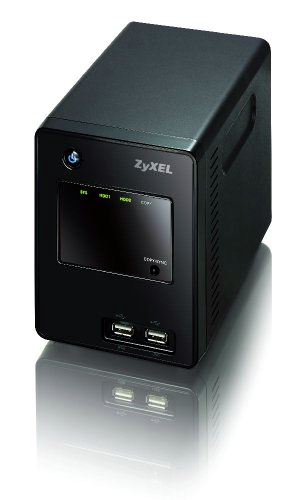
3TB Maximum Storage Capacity Support
Auto-upload Photos and Videos to Flickr and YouTube
BT/HTTP(S)/FTP(S) for Auto-download
Built-in RSS Server and Client for Auto-uploads and Status Updates
Why¶
This review is about the Zyxel NAS-220 Plus storage device.
Since I was running out of disc space and some new hobbies which I’ve recently started don’t seem to support my lack of disc space (taking pictures, to just mention something). Therefore a new solution was needed. My initial plan to just continue using my favourite IDE HDD witch capacities above the current 320GB doesn’t seem to be supported very well, since I couldn’t find a disc with a high capacity only close to me. It looks like many things have changed, since I bought my last hard drive. Almost everything is running on SATA (at least). But upgrading my board for just a new disc, well that’s far too much work.
But data still needs to be kept redundant (for safety reasons) and a NAS is obviously the matter of choice.
I just had some requirements towards a NAS, which I think are quite essential:
Supports RAID 1
File-system must be accessible even without the NAS, therefore common file-systems need to be supported.
This doesn’t seem to be too much, but especially the second requirement isn’t fulfilled by all NAS Devices. Especially the Netgear MS2110 which was one of my first choice, doesn’t seem to support this. I haven’t tested it, so I’d be glad if someone can confirm this with some proper testing.
What?¶
After some initial search I discovered the Zyxel NAS-220 Plus Storage Device. Instead of listing all features here again, I’ll just redirect to the datasheet or to the web-page of the vendor.
In order to sum it up: This device seemed to fulfill all my requirements and even offered me a built-in Bit-torrent client.
So I ordered it on Monday and just two days later it was already waiting for me at the post office, being ready to picked up.
First of all: The package was smaller than expected. An not even that heavy.
I ordered also two 1.5TB SATA discs, just to have full redundancy. As you can see on the first picture: there’s not much in the box:
NAS Storage
Cat5 Cable
Power Supply
Power Cable
Manual
Driver and Software disc
The hard-disks are extra and not included. The Storage container itself is surprisingly small, a colleague was really surprised; he expected at least the size of two toasters.
The access to the device is via the backside, therefore I opened the screws (which are fixed and won’t fall off at all).
I was a little bit surprised by the cable of the fan: this one is really short and allows the back cover just to get aside of the back side, so that you can reach the inner parts of the chassis. Maybe this isn’t the best solution, but it’s a possible one and nothing will break that way.
By opening the back cover I got access to the slides inside where I was probably supposed to mount the drives. With two screws on the right side the slides are just fixed in the position and mainly stabilized by some rails. This way they don’t move a single millimeter.
The next step was to remove the screws and to get the slides out. For an old, experience worker like me, of course, this isn’t a big problem. So I just grep the slide, mounted the drives with the delivered screws (always one spare screw in there as well) and shifted the whole thing back into the chassis.
Of course, one of the screws for fixing the slides into the chassis felt into it, but that wasn’t a big problem. A little bit shaking and it came back out.

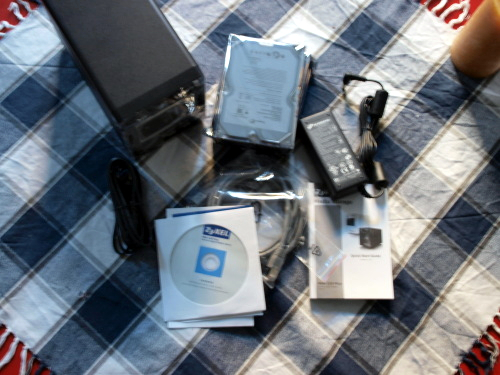
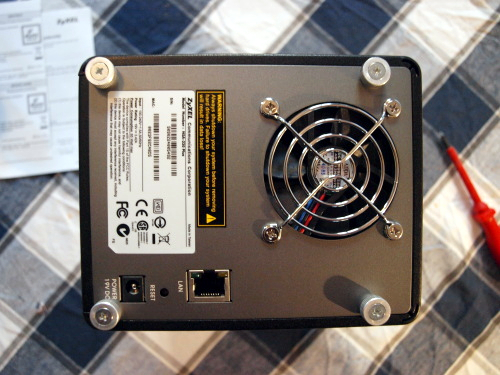
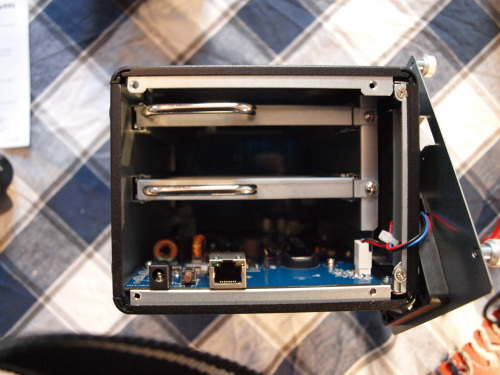
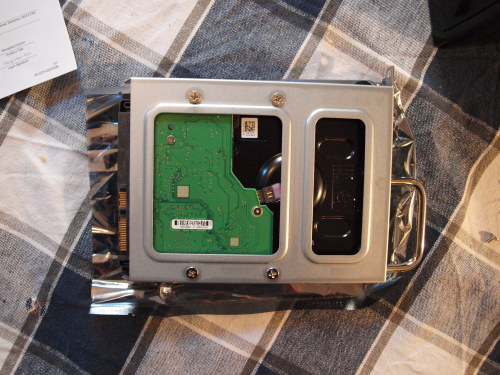
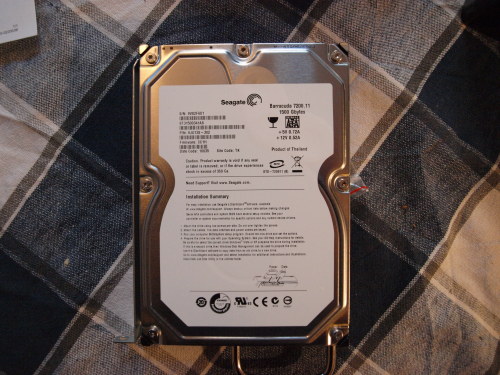
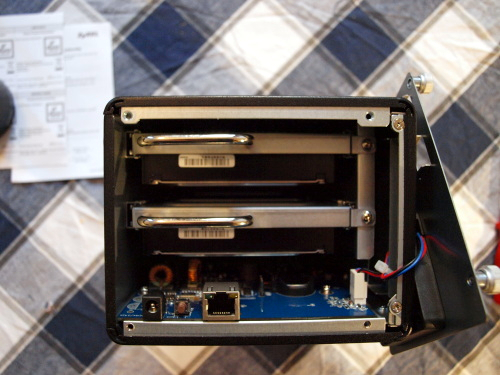
How?¶
The NAS ….¶
It was a little bit tricky in the beginning to get access to the device, since I don’t use Microsoft Windows at all (except from a CD drive less PC which I haven’t reinstalled yet), I couldn’t use the delivered application on the CD and the documentation didn’t give any hints how to contact it alternatively.
So I logged on into the central router the checked the DHCP client list … and there it was. It called itself NASSTORAGE and took the next available IP address. Lucky me.
Then it was quite easy to access the Web-Interface with the favourite browser of my choice. The initial user-name and password I could easily find with the manual and - I really appreciated - it asked me to change it after the first login.
The status page gave me quick overview on the current status and as expected I could see a lack of configured discs. So this was the first thing to do. When selecting _storage_ most options are self explaining and it was quite easy to set-up a raid-1 configuration on the two drives.
While the setup was done in just a couple of minutes, the synchronization of the two drives took about the rest of the evening (5 to 6 hours). Unfortunately I couldn’t stop myself and started playing around with the shares and user rights before the synchronization has finished what resulted in un-editable, 0byte files which I created to testing purposes. To be honest: I was just guessing the storage would be already accessible during the synchronization like you’re used to do when installing a server. But this is home consumer product stuff, and that’s how it works.
So just finished the configuration of the users, groups and shares and waited until the synchronization finished. After that anything else was quite easy. So I started the copy process of the first 20GB during night and also started some Bit Torrent downloads, in order to test this as well. It’s a little bit hard to import the torrent files manually, each one step by step, but since I’m not the big Downloader at all, this doesn’t really matter for me.
The client…¶
When I got up six hours later the download has finished completely and the copy process as well. Not all files has been copied successfully, but this probably had something to do with the rights and some weird file-names, as far as I could see from the log. The main question for me was: Can I access the files even without the NAS. In a scenario where the NAS fails and wouldn’t be accessible at all, it’s quite crucial to be able to access the files.
So I shut-off the NAS storage, removed a drive and connected it to my Linux machine via USB…. and it failed. The error message from /var/log/syslog was like
device not accepting address:
Wonderful. I like those messages. Via a search engine I found a forum entry mentioning the command
$ sudo rmmod ehci_hcd
This actually worked. As soon as I remove this module from the running configuration and reconnected the disc again, at least the first partition(?) was mounted automatically. First partition? I forgot that the NAS will use a bit of the storage of internal backup and configuration. But I didn’t find the reason for the second partition not being mounted.
fdisk showed everything nicely and described the file-systems as _AIX_; therefore nothing to worry about.
$ sudo fdisk -l
Disk /dev/sdd: 1500.3 GB, 1500301910016 bytes
255 heads, 63 sectors/track, 182401 cylinders
Units = cylinders of 16065 * 512 = 8225280 bytes
Disk identifier: 0x00000000
Device Boot Start End Blocks Id System
/dev/sdd1 1 64 514048+ 8 AIX
/dev/sdd2 65 182401 1464621952+ 8 AIX
A quick cross-check of the chosen file-system for the mounted partition returned ext3:
$ mount
[..]
/dev/sdd1 on /media/disk-1 type ext3 (rw,nosuid,nodev,uhelper=hal)
So I decided to just give it a go and tried to mount the partition:
$ sudo mount -t ext3 /dev/sdd2 /media/disk
Success. I could access the files. That’s all I wanted. So I unmounted the disc, removed it and loaded the module back into the system:
$ sudo modprobe ehci_hcd
After I reinstalled the disc in the NAS device and booted it the raid was still healthy (Though I haven’t changed anything on the disk, this was still surprising). I started the copy process of the rest of the files and left my home to work.
Conclusion¶
Well. After just a couple of days using it, this device seems to be quite fine and not too expensive at all. Especially that I can access the files anyway, even without the NAS, keeps my sleeping quite well.
In total the software running the NAS give me the impression of a proper and solid implementation. New features with new firmware and/or the packaging system are not necessarily very rich on features, but whatever is implemented seems to work quite solid and without any problem.
So far I couldn’t find a real bug (e.g: “Don’t press the button under this and that circumstances, otherwise the system will crash”). This can be based on
proper testing of the new firmware before deploying it into the wild, or
just luck
Usually luck is leaving quite quickly and rarely stays more than two following firmware versions (based on my experience, please correct me if I’m wrong). Therefore I tend to the first reason.
The box isn’t big, nothing very special about it and if it’s still working in one year, I’ll be more than happy.
Updates¶
2009-10-13¶
OK. Here some updates. Now one week is over (more or less) and I’ve gathered some more information about the device:
The system supports files >4GB. Therefore I assume this definitively isn’t a Windows file-system and not limited to 4GB. I created an empty file with 4.8GB size, can access it, move it and do all the dirty stuff people usually do with their files.
Currently I’ve got minor problems with files, which are named identically and just differ in their way of writing. The file-system doesn’t seem to support separation of upper- and lower-case file-names. Maybe this is somehow related to the way I mounted the share via cifs, but this I haven’t figured out yet. I’ll mount the share using a windows machine and test it from there. This should give similar results.
Hardware¶
Although I originally didn’t want to talk about the used hardware for the NSA-220 Plus, is there something I have to mention.
USB: The external USB connector seems to be a prober one. I tested some mobile phones on it, which had some slightly small difficulties with charging on a Laptop from Dell (I should mention, that Dell usually sticks very strictly to the USB specification, which results often into annoying problems like not working USB scanners or not charging mobile phones). There were no problems so far and I’m happy that I can easily access and USB-connector for charging several devices without using my computer.
Size: This thing is small. I mean really small. It looks IMHO quite impressing on the product pictures and I thought about where to put it before I bought it. But now I can hide it behind some flowerpots.
Support¶
While struggling with the NFS problem I had contact with the support. Although you might have difference experience with other companies (or even with Zyxel) I have to say that my experience with the Zyxel support is right away positive. They always answered in the in a short time, had new information as well and I always felt quite good informed about the actual status of the ticket. That’s quite rare, IMHO.
Limitations¶
All the limitations on this page are addressed to The NSA-220 Plus with a running firmware version of 3.22(AFG.0)C0 and might be possible solved afterwards by another upgrade.
SMB-Server¶
The current Share functionality (SMB shares) has its limitations regarding:
The Samba server doesn’t separate between upper and lowercase filenames. The files “Test.txt” and “test.txt” are identical from the servers point of view. This is contrary to the build in NFS Server and there’s no option to make the behaviour of of the two file server services identical.
It’s not possible to make an NFS exported share available via SMB as well.It’s working.
FTP-Server¶
It’s not possible to configure multiple FTP-Upload servers and link them individually to specific source folders. Currently it’s just possible to define one single source folder and a single upload server (multiple ones haven’t been tested yet).
NFS-Configuration¶
I had some trouble with configuration of the NFS server on that device. Maybe I’m too advanced, maybe I’m not. My goal actually was to offer the same data I’m serving via SMB also via NFS.
To start with I installed the NFS package using the package manager and created a share in the NFS server. I somehow couldn’t point towards the same share I was using on the SMB share. I decided to ignore this until I’m more familiar with the settings. The whole configuration and features of the new firmware are somehow not mentioned in in any manual I could find.
As like in the SMB shares I defined the permissions for the NFS share. Since NFS is more based on client side authentication (means the client checks the access rights instead the NFS-Server), I was a little bit confused that I could also define User access rights for the share and not only permitted clients for connection. Maybe someone can enlighten me regarding this point?
I also had to publish the share (I almost forgot that). Then I was finally able to mount the share into my file-system.
But I was struggling with publishing the existing SMB share via NFS. When creating an NFS share I was just able to export a new share, not the existing one. That lead into two different internal shares and the fact, that I couldn’t access via SMB and NFS to the same data share.
I contacted the support to sort this out, but the question was finally answered by the Zyxel forum (although the support answered continuously and with personal support, not text-bricks).
According to the support forum using the same share and the SMB via NFS hasn’t been specified in version (1.1.4zypkg001). That’s what I thought.
Therefore I’ll mainly stick to the SMB configuration until accessing the share via NFS is available (if it will be available).
update (2009-11-10)¶
And it’s possible, though. Today I got an answer from the support, including a short step-by-step guideline to follow. The result: It’s possible:
On NSA220 Plus, please first go to Applications - Package Management and install NFS
Go to Network - NFS, create NFS share, for example, “data”.
Next go to Sharing - Shares, select share “nfs” and edit this share -> Click enable this share.
After that, you can access this NFS share “data” from SMB.
I’ve followed those steps and I have to admit: Yes it’s working. And to be honest: It’s that easy, almost too easy, so that a normal user should have found out on it’s own.
Anyway: I’ll start testing the reliability of it as well and will see how it acts with big files and much, much data on it.
Firmware Upgrade¶
Well. Beside playing around with the NAS I figured out that there is a firmware upgrade available which adds a NFS feature to the NSA-220+. This is awesome! Therefore I needed to upgrade the firmware on the device. No other chance.
I was wondering because the link on the vendors page points to version 3.12, although within the Zyxel forum people are talking about a new version (v. 3.21). Some minor investigations on the the ftp server of Zyxel lead to the correct file.
According to the documentation the firmware upgrade is quite easy and: yes, I have to admit, it is. Apart from some minor problems:
The firmware upgrade doesn’t work with the opera browser. You need to use one of the supported ones, e.g. Internet Explorer or Firefox. If you try it with Opera you’ll get error messages like Invalid bin-file.
You really have to clear your browser cache and to restart your browser after the firmware upgrade. If you don’t do it you shouldn’t wonder about if you don’t see any changes after the reboot.
After uploading the bin-file and the installation of it the device will restart automatically and make the new firmware active. When the device was accessible again, all configuration data seemed to be still in place and nothing was lost. Well done. I had expected the worst, but didn’t make a backup of the configuration before (since it is somehow still in testing-mode and not many options are configured.).
There’s a couple of new features with the new firmware with even I find interesting.
XFS file system on new volumes
User quota support on XFS support
Package management for function extension from Zyxel
NFS Support via package management
DynDNS via package management
Backup planner
E-Mail alert from watching the internal logs
Update: (2009-11-01)¶
Zyxel has published another update in the meantime, which I haven’t seen. In addition they had included a firmware upgrade check inside the NAS-OS. It can be now easily checked for new firmware versions by the OS itself. That’s what I call a nice, but meaningful improvement.
Update: (2009-11-02)¶
I got a response from the support: their main office can’t reproduce the error and they we’re asking me for some screen-shots. So I sent them.